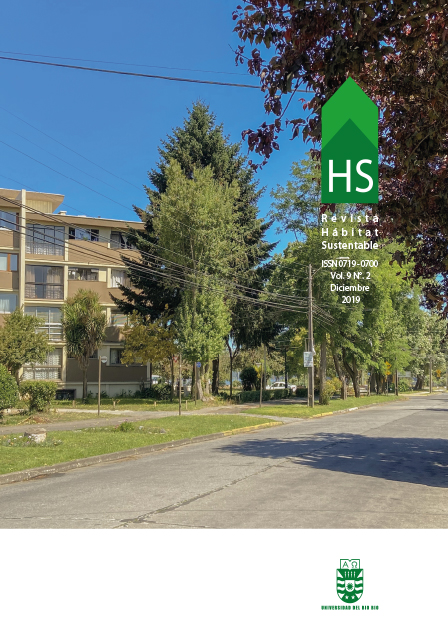An evaluation of the improvement of thermal comfort with the incorporation of sustainable materials in selfbuild dwellings in bosa, Bogotá, Colombia
DOI:
https://doi.org/10.22320/07190700.2019.09.02.03Keywords:
Confort térmico, materiales sostenibles, vivienda.Abstract
The use of sustainable materials incorporates environmental benefits, especially for large cities due to the current high levels of pollution (Fernández-Agüera, Domínguez-Amarillo, Alonso, & Martín-Consuegra, 2019). Cement, brick and Steel is the most used materials in construction and they are the ones that generate the most CO2 emissions in its manufacturing process. This article assesses how the incorporation of sustainable materials could improve thermal comfort in a home in the process of self-construction, in the San José de Bosa neighborhood in Bogotá, Colombia. The problem of Comfort was addressed as a fundamental condition of housing. Housing responds to a need for habitat understood as the need to have its own space regardless of the way in which this space responds to climatic variables. In the methodology used, periodic measurements were made with the objective of determining the thermal balance and how the materials used responded to the existing climatic conditions, to improve thermal comfort, sustainable materials were incorporated and measurements were made to determine if the new materials thermally insulated the House.
Downloads
References
C. Sekhar, D., & Nayak, S. (2018). Utilization of granulated blast furnace slag and cement in the manufacture of compressed stabilized earth blocks. Construction and Building Materials, 166, 531–536. https://doi.org/10.1016/J.CONBUILDMAT.2018.01.125
Chowdhury, D., & Neogi, S. (2019). Thermal performance evaluation of traditional walls and roof used in tropical climate using guarded hot box. Construction and Building Materials, 218, 73–89. https://doi.org/10.1016/j.conbuildmat.2019.05.032
Fernández-Agüera, J., Domínguez-Amarillo, S., Alonso, C., & Martín-Consuegra, F. (2019). Thermal comfort and indoor air quality in low-income housing in Spain: The influence of airtightness and occupant behaviour. Energy and Buildings, 199, 102–114. https://doi.org/10.1016/j.enbuild.2019.06.052
Godoy Muñoz, A. de J. (2012). El Confort térmico adaptativo. Aplicación en la edificación en España. Retrieved from https://upcommons.upc.edu/handle/2099.1/18763
Heathcote, K. (2011). El comportamiento térmico de los edificios de tierra. Informes de La Construcción, 63(523), 117–126. https://doi.org/10.3989/ic.10.024
IDEAM. (2007). Portal GeoNetwork para datos espaciales e información. Sistema de Información Ambiental del Instituto de Hidrología, Meteorología y Estudios Ambientales (IDEAM). Retrieved August 11, 2019, from http://geoservicios.ideam.gov.co:8080/geonetwork/srv/spa/catalog.search;jsessionid=0758FF83B771AFADEBCB46A817AD9B67#/search?facet.q=topicCat%2FclimatologyMeteorologyAtmosphere
Jones, R. V., Goodhew, S., & de Wilde, P. (2016). Measured Indoor Temperatures, Thermal Comfort and Overheating Risk: Post-occupancy Evaluation of Low Energy Houses in the UK. Energy Procedia, 88, 714–720. https://doi.org/10.1016/j.egypro.2016.06.049
Robledo-Fava, R., Hernández-Luna, M. C., Fernández-de-Córdoba, P., Michinel, H., Zaragoza, S., Castillo-Guzman, A., … Selvas-Aguilar, R. (2019). Analysis of the Influence Subjective Human Parameters in the Calculation of Thermal Comfort and Energy Consumption of Buildings. Energies, 12(8), 1531. https://doi.org/10.3390/en12081531
Walsh, P. J., & Delsante, A. E. (1983). Calculation of the thermal behaviour of multi-zone buildings. Energy and Buildings, 5(4), 231–242. https://doi.org/10.1016/0378-7788(83)90011-7
Downloads
Published
How to Cite
Issue
Section
License
The content of articles which are published in each edition of Habitat Sustentable, is the exclusive responsibility of the author(s) and does not necessarily represent the thinking or compromise the opinion of University of the Bio-Bio.
The author(s) conserve their copyright and guarantee to the journal, the right of first publication of their work. This will simultaneously be subject to the Creative Commons Recognition License CC BY-SA, which allows others to share-copy, transform or create new materials from this work for non-commercial purposes, as long as they recognize authorship and the first publication in this journal, and its new creations are under a license with the same terms.











 Scientific Information Program/Concurso Fondos de Publicación de Revistas Científicas 2018/ Proyecto Mejoramiento de Visibilidad de Revistas UBB (Código:FP180007).
Scientific Information Program/Concurso Fondos de Publicación de Revistas Científicas 2018/ Proyecto Mejoramiento de Visibilidad de Revistas UBB (Código:FP180007).





